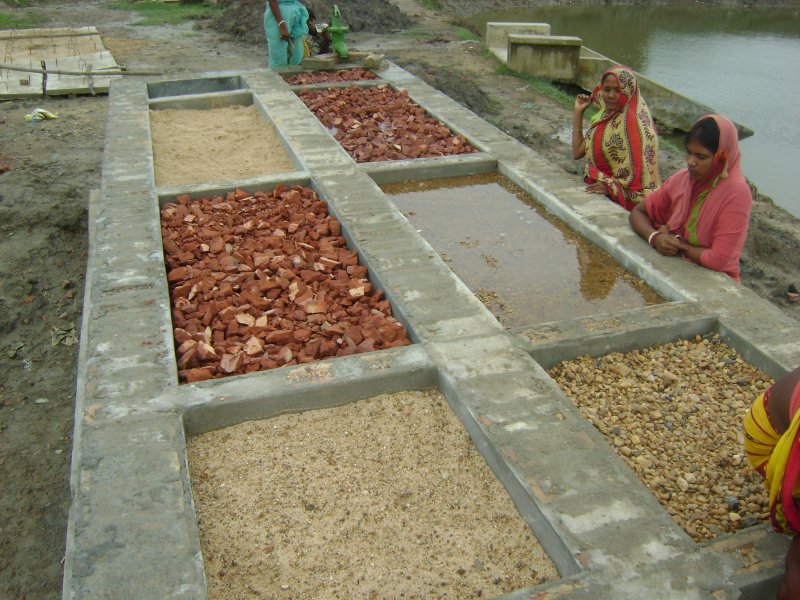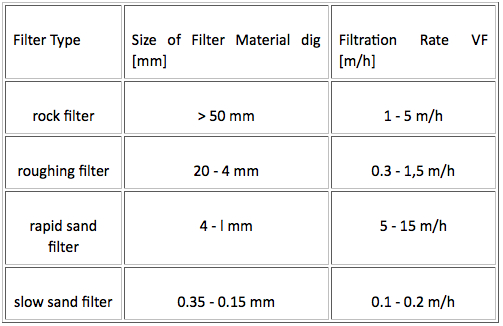Upflow roughing filter
| |
|
|
|
|
|
|
|
|
|



Roughing filters are often used to pretreat water by removing suspended solids from the water that could rapidly clog a slow sand filter. Roughing filters can also considerably reduce the number of pathogens in the water, as well as the amount of iron and manganese. There are many types of roughing filters with different flow directions (downflow, upflow and horizontal flow filters), and with different types of filter medium (e.g. sand, gravel, coconut husk fibre). Upflow roughing filters are relatively cheap and easier to clean than downflow or horizontal flow filters.
An upflow filter box can be made of bricks, concrete or ferrocement. It can have a round or rectangular shape, with vertical or partially inclined walls, and it is usually about 1.5 m deep. Water flows in through an underdrain system on the bottom, usually a perforated PVC pipe, which also permits rapid abstraction during cleaning when the flow direction is reversed (backwashing).
For backwashing, a special drainage valve is installed which can be opened quickly. The underdrains are covered with a layer of coarse gravel, on top of which lie several layers of finer gravel and coarse sand. The filter layers are covered with a 0.1 m-deep layer of boulders, to avoid exposing the outflow directly to sunlight; this helps to prevent algal growth. The outflow is stored in an outlet structure. In some cases, the outflow of one roughing filter is fed to another roughing filter with finer material for further cleaning.
Filtration rate: Approximately 0.6 m/h.
Performance: If raw water with a turbidity below 50 NTU is used as the source for a roughing sand filter, the outflow has a turbidity below 12 NTU. Approximately 84–98% of suspended solids are removed. Better results are obtained with two or three filters in series.
Contents
Suitable conditions
Use: As a pretreatment stage prior to slow sand filtering or other purification processes.
Construction, operations and maintenance
The filters should preferably be operated on a continuous basis. Operation consists of regulating the water flow and checking the turbidity of the effluent. Flow, turbidity and maintenance data are written in a logbook. If the turbidity gets too high, the filter may become clogged. In such cases, the filter should be cleaned about once a month, while leading the effluent to outlet. The inlet and outlet boxes are then cleaned, and backwashing and refilling are done twice. The monthly cleaning is performed by the caretaker and takes about half a day. No special assistance from users is required to clean the filters. Every two months, all valves should be completely opened and closed, to keep them from becoming stuck.
After a year or more (depending on the turbidity of the raw water), hydraulic cleaning alone is no longer adequate, and the different filter layers have to be removed and cleaned, which requires several people. The filter should be cleaned before the turbidity of the raw water reaches a maximum (e.g. before the rainy season starts). Occasionally, the valves need to be repaired or replaced, and if a steel weir is used this may need to be painted or replaced. New caretakers can be trained by experienced technicians.
Caretaker training
Comprehensive training of local staff is essential since technical installations must be run by operators. While most technical problems can be eliminated or reduced by appropriate design and construction, human aspects which might affect treatment plant operation are more difficult to control. Careful, formal training of caretakers and extensive support, guidance, and supervision in the first years of operation are necessary.
Adequate payment of the local staff is equally important. The caretaker of a rural water supply usually has numerous duties; he is often in charge of treatment plant operation, maintenance of the water distribution system, collection of water taxes, clearing irregularities and complaints, etc. Motivation alone will not keep him on the job; his or her work must be adequately compensated.
The caretaker should be recruited from the local village, he should preferably be settled, married, land owner and well-recognised by the community. Ideally, he should also have some technical skills, however, interest and motivation to run a water supply system are more important criteria for his election. He should show his interest and skills during construction of the treatment plant. However, the future caretaker should preferably not be selected during the construction phase of a project but after assessment of the performance of different candidates during this period by the construction foreman and the design engineer who could then propose qualified candidates to the water committee for election. Each caretaker must also have a deputy who can assume operation of the water supply during his absence for reasons of illness, personal matters or other obligations. However, responsibilities of the different staff must be clearly defined and separately developed for each employee.
Filter maintenance
Filter maintenance is not very demanding as the prefilters do not include any mechanical parts apart from the valves. Nevertheless, maintenance should aim at maintaining the plant in good condition right from the beginning. External assistance for maintenance work can usually be avoided if the following work is carried out properly by the local caretaker:
• periodic upkeep of the treatment plant's premise (grass cutting; removal of small bushes and trees which could impair the structures by their roots; removal of refuse)
• soil protection against erosion (especially surface water intake structures, the washwater drainage channels and surface runoff)
• repairing fissures in the walls of the different structures and replacing the chipped plaster
• application of anti-corrosive agents to exposed metal parts (V-notch weirs, gauging rods, pipes)
• checking the different valves and drainage systems, and occasionally lubricating their moving parts
• weeding the filter material
• skimming off floating material from the free water table
• washing out coarse settled material (distribution and inlet boxes)
• controlling the ancillaries and replacing defective parts (tools and testing equipment).
Potential problems
- High loads of organic and other suspended material in the raw water clog the filter and reduce the hydraulic cleaning capacity.
- Roughing filters only remove some of the solids and pathogens in the water, and additional treatment is needed.
Costs
Initial cost: Reported construction costs are US$ 20–40 per m3 of water per day, for a structure designed to be in operation for 24 hours a day.
Field experiences
Kenya study
A study was investigated by Ochieng and Otieno (2004)in a pilot plant built at Moi University in Kenya using broken burnt bricks and charcoal, as filter media for removal of Suspended solids and turbidity. They noted that broken burnt bricks and improved agricultural waste (charcoal Maize cobs), can also be effectively used as pretreatment media and therefore could serve as alternatives where natural gravel is not readily available. The design and sizing of the pilot plant was guided by Wegelin design criteria and a constant filtration rate of 0.75 m/h was chosen for the HRF units. It was observed that in general both broken burnt bricks and charcoal performed better than gravel. This observation could have resulted from the reason that both charcoal maize cobs and broken burnt brick have a slightly higher specific surface area and porosity respectively to enhance the sedimentation and other filtration processes compared to gravel.
African Killer Bees Supported Sustainability
The rapid sand filters of Salaga, a district centre located in West Africa, were never filled with filter media and the population of the town was therefore exposed to unsafe water. The old treatment plant had to be extended and replaced by an appropriate treatment scheme. Roughing and slow sand filters were thus tested in a pilot plant shaded by a large baobab tree. The location was chosen by the external experts suffering from the Ghanaian sun. The pilot plant was constructed by the local water authority, and the expatriates supervised the start of the field tests. However, African killer bees also chose the same large baobab tree as their habitat and were very much attracted by the white skin of the foreigners. Under remote supervision by the expatriates, the field tests were continued by the local staff which gained experience and confidence in a treatment scheme they wit/have to run in future at full scare and without foreign assistance. Thus, the African killer bees somehow contributed to developing local sustainability.
Acknowledgements
- Brikke, François, and Bredero, Maarten. Linking technology choice with operation and maintenance in the context of community water supply and sanitation: A reference document for planners and project staff or (alternative link). World Health Organization and IRC Water and Sanitation Centre. Geneva, Switzerland 2003.
- Surface water treatment by roughing filters - A design, Construction and Operation manual (1996). SANDEC.
- Onyeka Nkwonta and George Ochieng. Roughing filter for water pre-treatment technology in developing countries: A review. Tshwane University of Technology, South Africa. July, 2009.

